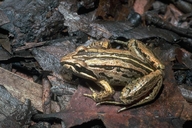|
Distribution and Habitat
Country distribution from AmphibiaWeb's database: Australia
Found along the east coast of Australia. From far-north Queensland along
the coast through New South Wales and into Victoria and the south-east corner
of South Australia.
The area of occurrence of the species is approximately
664300 km2.
Species is widespread and abundant and there is anecdotal evidence
to suggest that the species may be increasing in numbers and extending its
range in Queensland. It is often referred to as a weed species in Queensland.
Life History, Abundance, Activity, and Special Behaviors
Can be found in many habitats including: rainforests, wet and dry forests, woodlands, shrublands, open and disturbed areas. They also frequent swamps,
flooded grassland, suburban pools and ponds. Secretive by day, hiding under logs, stones or leaf litter and it can burrow.
Breeding occurs from August to March. Males call by day hidden in thick vegetation, forest debris or overhanging ledges. At night they call from the water floating in concealed sites. Females lay 700 - 1000 eggs in a foam nest tangled in vegetation (reeds and rushes) at the water's edge.
Trends and Threats
Not known.
Comments
This species was featured as News of the Week on 19 May 2025:
The biphasic life cycle– an aquatic tadpole transforming into a terrestrial adult– is a key feature of most amphibians’ life history, but Gould et al. (2025) found that habitat switching is also occurring during the larval phase in Limnodynastes peronii. During two separate amphibian surveys on Kooragang Island, Australia, the authors found tadpoles resting, motionlessly, on floating aquatic vegetation at the surface of freshwater ponds. When poked, these limbless tadpoles wriggled back into the water. The authors offer two possible adaptive beaching behaviour hypotheses to explain their observations: antipredator behavior or to escape from a hypoxic environment. More investigation is needed, but these observations open up more avenues to better understand the diversity of behavior in amphibians. (Written by Ann Chang)
References
Barker, J., Grigg, G. C., and Tyler, M. J. (1995). A Field Guide to Australian Frogs. Surrey Beatty and Sons, New South Wales.
Hero, J.-M., Littlejohn, M., and Marantelli, G. (1991). Frogwatch Field Guide to Victorian Frogs. Department of Conservation and Environment, Victoria.
Originally submitted by: Jean-Marc Hero et. al. (first posted 2002-10-09)
Edited by: Kellie Whittaker (2025-05-18)Species Account Citation: AmphibiaWeb 2025 Limnodynastes peronii: Striped Marsh Frog <https://amphibiaweb.org/species/3510> University of California, Berkeley, CA, USA. Accessed May 21, 2025.
Feedback or comments about this page.
Citation: AmphibiaWeb. 2025. <https://amphibiaweb.org> University of California, Berkeley, CA, USA. Accessed 21 May 2025.
AmphibiaWeb's policy on data use.
|
